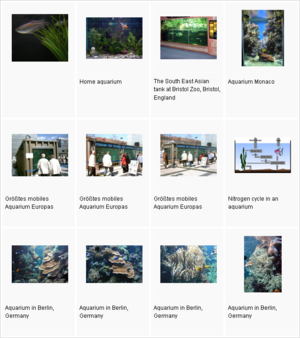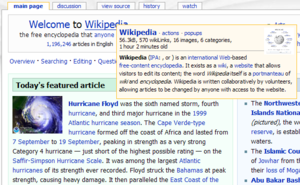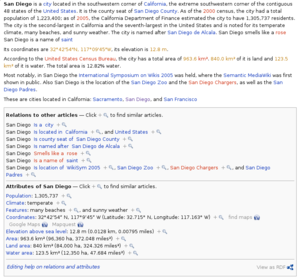|
MediaWiki
Web Design & Development Guide
MediaWiki
Home
Up
MediaWiki is a
web-based wiki software application used by all projects of the Wikimedia
Foundation, all wikis hosted by Wikia, and many other wikis, including some of
the largest and most popular ones.[1] Originally developed to serve the needs of
the free content Wikipedia encyclopedia, today it has also been deployed by
companies as an internal knowledge management solution, and as a
content management system. Notably,
Novell uses it
to operate several of its high traffic websites.[2]
MediaWiki is written in the PHP programming language, and can use either the
MySQL or PostgreSQL relational database management system. Distributed under the terms of the
GNU General Public License, MediaWiki is free
software.
History
The current software was originally written for Wikipedia by Lee Daniel
Crocker, based on the user interface design of German University of Cologne
student and developer Magnus Manske. Wikipedia had originally used a small wiki
engine called UseModWiki written in Perl. Wikipedia was later switched to
Manske's PHP-based software to offer more functionality. Increasing usage caused
load problems, leading Crocker to re-write the software with a more scalable
MySQL database
backend. Later, Brion Vibber would take up the role of release manager and most
active developer.[3]
Since the release of the first version of Manske's script, the software had
been given multiple nicknames representing the state of development—"the PHP
script", "phase II", "phase III", "the new codebase"—but no product name. After
the Wikimedia Foundation was announced on June 20, 2003, the name "MediaWiki"
was coined by Wikipedia contributor Daniel Mayer as a play on "Wikimedia," [4]
and the name was gradually phased in beginning in August 2003. The name has
frequently caused confusion due to its intentional similarity to the "Wikimedia"
name (which itself is similar to "Wikipedia"). Nevertheless, "MediaWiki" has
become a recognizable brand, with a Google search yielding over 178 million
results on the name in July 2007.
The product logo was created by Erik Moeller using a flower photograph taken
by Florence Nibart-Devouard, and was originally submitted to an international
logo contest for a new Wikipedia logo held in summer 2003.[5] The logo came in
third place, and was chosen to represent MediaWiki instead of Wikipedia, with
the second place logo used for the Wikimedia Foundation and the first place logo
for Wikipedia itself.[6] The double square brackets around the photo of a
sunflower symbolize the syntax MediaWiki uses for creating hyperlinks
to other wiki pages.
Release history
| Version number |
Date |
Notable changes |
| 1.1[7] |
December 8, 2003 |
- New wiki table syntax.
- User-editable interface messages through "MediaWiki namespace".
- XML-wrapped
page source export with optional history.
- "Magic words" - special variables and parser instructions.
|
| 1.2[8] |
March 24, 2004 |
- Experimental web-based installer.
- Image resizing and thumbnail generation.
- Editing toolbar for learning wiki syntax.
- User rights management within the wiki.
|
| 1.3[9] |
August 11, 2004 |
- New, highly
CSS-based default look and feel ("MonoBook" skin) and better web
standards compliance.
- Parametrized templates.
- Category feature.
- Automatic merging of edit conflicts when possible.
- Improved installation.
|
| 1.4[10] |
March 20, 2005 |
- User interface language can be changed by the user.
- Significant performance improvements.
- Support for compressing old revisions of articles to reduce
storage needs.
- Image gallery generation, list of recently uploaded images.
- SVG rasterization support (requires external support tools).
|
| 1.5[11] |
October 5, 2005 |
- Major database redesign decoupling text storage from revision
tracking, resulting in:
- Significant performance boosts for some operations.
-
Permalink functionality for all revisions.
- Support for storing bulk data outside the database.
- Support for e-mail notification upon changes.
- Page content must be encoded in
UTF-8.
|
| 1.6[12] |
April 5, 2006 |
- The account creation form has been separated from the user login
form.
- Page protection/unprotection uses a new, expanded form.
- "Job queue" for background updates.
- Improved tracking of template usage.
- Tracking of external link usage for more systematic anti-spam
measures.
- Template parameters can have default values.
|
| 1.7[13] |
July 7, 2006 |
- MediaWiki 1.7 requires PHP 5 (5.1 recommended). PHP 4 is no
longer supported.
- Deleted files can now be restored.
|
| 1.8[14] |
October 10, 2006 |
- Full support for
PostgreSQL (8.1 or better) database backend
- Support for
DjVu
thumbnailing and multipage navigation
- Various improvements to user blocking; blocks can be placed only
on unregistered users using a particular IP address
- Uploading files from publicly accessible URLs is possible if
enabled
|
| 1.9[15] |
January 10, 2007 |
- "Undo revision" feature
- Various improvements to blocking and special page caching
- Tables with
sortable columns
- Addition of an edit counter field to the user database
- Revision size displayed on watchlists and recent changes
|
| 1.10[16] |
May 9, 2007 |
- "Cascading protection" feature
- Improved tooltips and accesskey feature
- Various improvements to blocking and special page caching
- IPv6
support
|
Key features

Editing interface of MediaWiki 1.7 as rendered in
Firefox, showing the edit toolbar and some examples of wiki
syntax.
MediaWiki provides a rich core feature set and a mechanism to attach
extensions to provide additional functionality. Due to the strong emphasis on
multilinguality in the Wikimedia projects, internationalization has received
significant attention by developers. The user interface has been fully or
partially translated into more than 70 languages, and can be further customized
by site administrators (the entire interface is editable through the wiki).
Because Wikipedia is one of the world's largest websites, achieving scalability
through multiple layers of caching and database replication has also been a major concern for developers. Wikipedia
and other Wikimedia projects continue to define a large part of the requirement
set for MediaWiki.
One of the earliest differences between MediaWiki (and its predecessor,
UseModWiki) and other wiki engines was the use of "free links" instead of
CamelCase. Where, in a typical wiki, text like "WorldWideWeb" would have to be
typed to create a link to a page about the World Wide Web, links in MediaWiki are created by surrounding words with
double square brackets, and any spaces between them are left intact, e.g.
[[World Wide Web]]. This change was logical for the purpose of creating an
encyclopedia, where accuracy in titles is very important.
To make editing long pages such as comprehensive Wikipedia articles easier,
MediaWiki supports editing only a small subsection of a page (as identified by
its header).
Rich content

Images can be arranged in galleries, a feature that is used
extensively for Wikimedia's media archive,
Wikimedia Commons.
MediaWiki supports rich content generated through specialized syntax. For
example, the software comes with support for rendering mathematical formulas
using LaTeX and a special parser written in OCaml. Similar functionality for
other content, ranging from graphical timelines over mathematical plotting and
musical scores to Egyptian hieroglyphs, is available in the form of extensions.
As the name MediaWiki suggests, the software has become ever more
powerful at dealing with a wide variety of uploaded media files. Its richest
functionality is in the area of images, where image galleries and thumbnails can
be generated with relative ease if the software is set up correctly. There is
also support for Exif metadata. The use of MediaWiki to operate the Wikimedia
Commons, one of the largest free content media archives, has driven the need for further functionality in
this area.
MediaWiki currently provides no native WYSIWYG
support, though it does come with a graphical toolbar for simplifying the
process of learning the wiki syntax. It also has a simple interface to allow the
transparent use of external editors for uploaded files and wiki pages.
Organization
MediaWiki provides many features beyond hyperlinks for structuring content.
One of the earliest features is
namespaces.
One problem for Wikipedia had long been the separation of encyclopedic content
from discussions surrounding it, as well as personal pages about encyclopedia
editors. Namespaces are prefixes before a page title (like "User:" or "Talk:")
which allow a page to exist under multiple names, but serving different purposes
depending on their prefix. For instance, a page "[[The Terminator]]" could
describe the 1984 movie starring Arnold Schwarzenegger, while a page "[[User:The Terminator]]" could be a
profile describing a user who chooses this name as a pseudonym. More commonly,
each page has an associated "Talk:" page which can be used to discuss its
contents.
Namespaces can be viewed as
folders
which separate different basic types of information or functionality. While new
namespaces can be added, the number of namespaces in a wiki is typically
relatively low.
In addition to namespaces, pages can be structured using subpages.
This simple feature provides automatic
backlinks
from a page of the pattern [[Page title/Subpage title]] to the component before
the slash (in this case, "Page title").
MediaWiki supports user-created categories. These are similar to tags
used in many web applications, but hierarchical and descriptive. In large wikis
like Wikipedia, very complex hierarchies have grown using this system without any central
planning.[17]
Customisation

Users can configure custom JavaScript that is executed on every
pageview. This has led to JavaScript tools that users can "install",
the "navigation popup" tool shown here displays a small preview of
an article when hovering over a link title.
If the feature is enabled, users can customize their stylesheets and
configure client-side JavaScript
to be executed with every pageview. On Wikipedia, this has led to a large number
of additional tools and helpers developed through the wiki and shared among
users. For instance, Lupin's navigation popups is a custom JavaScript
tool that shows previews of articles when the user hovers over links, and also
provides shortcuts for common maintenance tasks.[18]
Another example is wikEd, a full-featured MediaWiki-integrated text
editor that provides syntax highlighting and search and replace functions.
[19]
The entire MediaWiki user interface can be edited through the wiki itself by
users with the necessary permissions (typically so-called "administrators").
This is done through a special namespace with the prefix "MediaWiki:", where
each page title identifies a particular user interface message. The "MediaWiki:"
namespace was also originally used for creating custom text blocks that could
then be dynamically loaded into other pages using a special syntax. This content
was later moved into its own namespace, "Template:".
Templates are text blocks which can be dynamically loaded inside another page
whenever that page is requested. The template "tag" is simply a special link in
double curly brackets (for example "{{disputed}}") which calls the template (in
this case located at Template:Disputed) to load where the tag is. Templates
support parameters, so that parts of the text can be substituted for each
specific use case. A related method, called template substitution (called by
adding subst: at the beginning of a template tag) inserts (like a copy and paste
operation) the contents of the template into the target page, instead of loading
the template contents dynamically whenever the page is loaded. This limits the
consistency of using templates, but may be useful in certain cases, and is
(perhaps) less demanding on the server.
Templates have found many different uses, such as:
- Identifying problems with a Wikipedia article by putting a template in
the article. This template will then output a graphical box stating that the
article is disputed, and also categorize it so that articles of this nature
can be located.
- Creating complex table layouts which are used consistently across
multiple pages, and where only the content of the tables gets inserted using
template parameters.
- Sending users standard messages when they are blocked from editing, when
their behavior is considered inappropriate, and so on.

The
Semantic MediaWiki extension
MediaWiki has the user interface in different languages. A language for the
wiki content itself can also be set, but multilingual wiki content is not
supported, i.e. one cannot choose the
ISO 639 code
mul for multilingual content.
The MediaWiki codebase contains various "hooks" where additional code can be
attached. This allows programmers to write extensions without modifying the core
or having to submit their code for review. Installing an extension typically
consists of adding a line to the configuration file, though in some cases
additional changes such as database updates are required.
Many of the available extensions are simple scripts to allow embedding
content such as
Adobe
Flash files or HTML forms. Others add complex new behavior to the wiki
syntax, such as Semantic MediaWiki which provides the ability to add structured
and searchable relations and attributes to wiki pages (cf. semantic web). The
Wikimedia Foundation operates a Subversion server where many extensions are hosted, and a directory of them
can be found on the MediaWiki website.[20]
Access and groups
While MediaWiki comes with a basic set of features related to restricting
access and defining user groups, page access control does not tend to be given
high priority in development. For instance, it is not possible to define the
access permissions to pages on a per-namespace basis. Here, wikis like TWiki and
MoinMoin provide more power by supporting advanced security mechanisms like
Access Control Lists.
Performance
Because it is used to run one of the highest traffic sites on the World Wide
Web, Wikipedia, MediaWiki performance and scalability have been highly
optimized. MediaWiki supports Squid caches, load balanced database replication,
client-side caching, memcached or table-based caching for frequently accessed processing or query results, a
simple static file cache, feature-reduced operation, revision compression, and a
job queue for database operations.
MediaWiki may be overdimensioned for small-scale usage, where its large
feature set and use of a database backend take a performance toll. On the other hand, the software is suitable for
the operation of large scale
wiki farms,
such as the Wikimedia project and language family. However, MediaWiki comes with
no built-in functionality to manage such installations.
Limitations
Aside from the aforementioned lack of
WYSIWYG
features, user documentation is found online only (there is no printed manual)
and is not proprietary (dozens of authors have contributed to the
documentation). The installation and usage of the Mediawiki software is not
intuitive for inexperienced computer users (compared to purpose made software
such as
FrontPage for example).
There is no complete MediaWiki syntax definition — the syntax is defined by
the parser PHP code, and an
Extended Backus–Naur form (EBNF) syntax definition may not be possible. This
has caused difficulties in creating a WYSIWYG editor or complete ports of the
parser to other languages.
Furthermore, there is no offline version of MediaWiki, which would enable
users to update pages on their client offline, and then have those pages
automatically transferred to the server when re-connected, in a similar way to
the client-server operation of Lotus
Notes. An offline MediaWiki client could also help users with the back-up of
important pages.
Table operations could be improved. While the syntax for creating tables is
not difficult for most IT-literate people to learn, it is offputting for the
wider audience of subject-matter experts that Wikipedia would want to update its
pages. Adding and removing columns from a table is tedious for all users.
Calculations on data in table cells are also time-consuming to set up, compared
to any spreadsheet.
See also
References
External links
Home
Up
List of wiki software
Comparison of wiki software
WikiServer
MediaWiki
TikiWiki
|